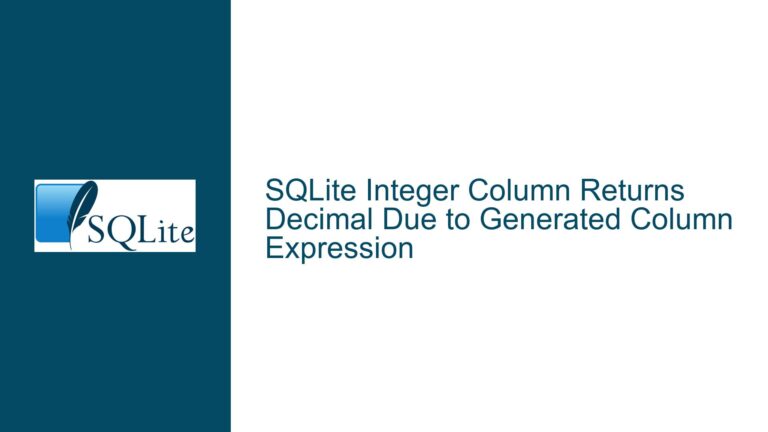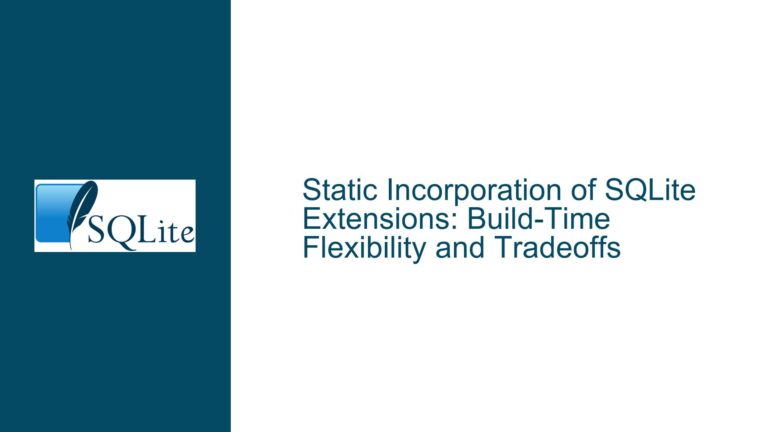AUTOINCREMENT in SQLite Table Constraints vs. Column Definitions
AUTOINCREMENT Behavior in Column Constraints vs. Table Constraints
Column-Level vs. Table-Level Syntax Validity
The core issue revolves around SQLite’s treatment of the AUTOINCREMENT keyword when used in column constraints versus table constraints. According to the official SQLite syntax diagrams, AUTOINCREMENT is explicitly allowed only in column definitions where a PRIMARY KEY is declared as part of the column. For example:
CREATE TABLE MyTable (
_id INTEGER NOT NULL PRIMARY KEY AUTOINCREMENT,
message TEXT NOT NULL
);
This syntax is valid because AUTOINCREMENT directly follows the PRIMARY KEY clause in the column definition.
However, the same keyword is not documented as permissible in table-level constraints, where the PRIMARY KEY is declared separately from individual columns:
CREATE TABLE MyTable (
_id INTEGER NOT NULL,
message TEXT NOT NULL,
PRIMARY KEY(_id AUTOINCREMENT)
);
The syntax diagram for table constraints does not include AUTOINCREMENT as an allowed modifier for PRIMARY KEY definitions. Despite this, SQLite accepts the second syntax without errors and behaves as if AUTOINCREMENT were valid. This discrepancy arises from SQLite’s historical leniency in parsing certain constructs and its internal handling of INTEGER PRIMARY KEY columns.
The confusion is compounded by SQLite’s creation of the sqlite_sequence table when AUTOINCREMENT is used in either form. This table tracks the maximum rowid assigned to tables with AUTOINCREMENT, proving that the keyword is functionally active even in the table-constraint form. The documentation’s silence on this behavior creates ambiguity for developers and tools that rely on strict syntax validation.
Historical Evolution of SQLite’s Rowid and AUTOINCREMENT
SQLite’s rowid mechanics are central to understanding this issue. Every table in SQLite implicitly has a rowid column (unless replaced by an INTEGER PRIMARY KEY). When a column is declared as INTEGER PRIMARY KEY, it becomes an alias for rowid. The AUTOINCREMENT keyword modifies this behavior by enforcing that new rowid values must always increase and preventing reuse of deleted rowid values.
Historically, SQLite required the INTEGER PRIMARY KEY declaration to be a column constraint to trigger rowid aliasing. Over time, the parser was relaxed to allow PRIMARY KEY declarations in table constraints, provided the column type was INTEGER. This relaxation inadvertently extended to AUTOINCREMENT, even though the syntax diagrams were not updated.
This evolution explains why older tools (e.g., Android’s SqliteOpenHelper) and newer versions of SQLite (3.6.22 to 3.39.2) accept the table-constraint syntax. The parser treats PRIMARY KEY(_id AUTOINCREMENT) as equivalent to the column-constraint form if _id is of type INTEGER. However, SQLite’s error messages reveal inconsistencies. For example:
CREATE TABLE InvalidExample (
id INT NOT NULL,
msg TEXT,
PRIMARY KEY (id AUTOINCREMENT)
);
This produces Error: AUTOINCREMENT is only allowed on an INTEGER PRIMARY KEY, confirming that AUTOINCREMENT is context-dependent. The parser first checks whether the column is an INTEGER PRIMARY KEY before allowing AUTOINCREMENT, regardless of whether it is declared as a column or table constraint.
Syntax Parsing Leniency and Documentation Gaps
SQLite’s parser is designed to accept certain "dubious" SQL constructs for backward compatibility, as noted in the SQLite Quirks documentation. This leniency allows AUTOINCREMENT in table constraints to be parsed without error, even though it contradicts the official syntax diagrams.
The root cause lies in the parser’s handling of the AUTOINCREMENT keyword. When a table constraint includes PRIMARY KEY(_id AUTOINCREMENT), SQLite interprets this as a directive to apply AUTOINCREMENT to the _id column, provided _id is an INTEGER PRIMARY KEY. The parser does not strictly validate whether AUTOINCREMENT is in a column or table constraint, leading to unexpected validity.
Documentation gaps exacerbate the problem. The CREATE TABLE page explicitly states that AUTOINCREMENT can only be added to an INTEGER PRIMARY KEY column but does not clarify whether this applies to column constraints only. The syntax diagram’s omission of AUTOINCREMENT in table constraints creates a false impression that it is unsupported, while empirical testing proves otherwise.
Key Constraints in Column Definitions vs. Table Constraints
Column Constraint Requirements for AUTOINCREMENT
For AUTOINCREMENT to function correctly in a column constraint, the following must hold:
- The column must be declared as
INTEGER(case-insensitive but exact match required for type affinity). - The column must include
PRIMARY KEYeither inline or as part of a table constraint. AUTOINCREMENTmust directly followPRIMARY KEYin the column definition.
Violating any of these conditions results in errors. For example:
CREATE TABLE Invalid1 (
id INTEGER NOT NULL AUTOINCREMENT PRIMARY KEY, -- Syntax error: AUTOINCREMENT before PRIMARY KEY
msg TEXT
);
CREATE TABLE Invalid2 (
id INT PRIMARY KEY AUTOINCREMENT, -- Error: AUTOINCREMENT on non-INTEGER PRIMARY KEY
msg TEXT
);
Table Constraint Ambiguities and Silent Acceptance
When using a table constraint, SQLite applies the following logic:
- If the column referenced in
PRIMARY KEY(...)isINTEGER, it becomes an alias forrowid. - If
AUTOINCREMENTis appended to the column name in thePRIMARY KEYclause, SQLite silently accepts it and enablesAUTOINCREMENTbehavior.
This behavior is inconsistent with the documented syntax but aligns with SQLite’s historical permissiveness. For example:
CREATE TABLE ValidButUndocumented (
_id INTEGER NOT NULL,
msg TEXT NOT NULL,
PRIMARY KEY(_id AUTOINCREMENT) -- Works despite syntax diagram exclusion
);
Here, _id is an INTEGER column, so SQLite treats it as an alias for rowid and honors AUTOINCREMENT. However, if the column type is not INTEGER, an error occurs:
CREATE TABLE Invalid3 (
_id REAL NOT NULL,
msg TEXT NOT NULL,
PRIMARY KEY(_id AUTOINCREMENT) -- Error: AUTOINCREMENT on non-INTEGER PRIMARY KEY
);
Impact on Schema Validation and Tooling
The discrepancy between documented syntax and actual parser behavior affects:
- IDEs and Editors: Tools that rely on SQLite’s published syntax diagrams (e.g., JetBrains databases, VS Code extensions) flag
AUTOINCREMENTin table constraints as invalid, causing false positives. - Code Generators: ORMs and schema migration tools may refuse to generate valid SQLite schemas if they strictly follow the documentation.
- Custom Parsers: Developers using ANTLR, YACC, or other parser generators to process SQLite schemas face challenges replicating SQLite’s lenient behavior.
Resolving Schema Definition Conflicts and Parser Errors
Step 1: Validate Column Types and Key Constraints
Ensure that any column intended for AUTOINCREMENT meets these criteria:
- Declared as
INTEGER(exact spelling). - Designated as
PRIMARY KEYeither inline or via a table constraint.
Example of a valid column-constraint approach:
CREATE TABLE SafeExample (
_id INTEGER PRIMARY KEY AUTOINCREMENT,
msg TEXT NOT NULL
);
Step 2: Prefer Column Constraints for Clarity
To avoid parser and tooling ambiguities, use column constraints when applying AUTOINCREMENT:
-- Recommended
CREATE TABLE UnambiguousExample (
_id INTEGER NOT NULL PRIMARY KEY AUTOINCREMENT,
msg TEXT NOT NULL
);
This aligns with documented syntax and ensures universal acceptance by tools.
Step 3: Modify Table Constraints for Compatibility
If table constraints are necessary (e.g., composite keys), separate PRIMARY KEY from AUTOINCREMENT:
CREATE TABLE CompositeKeyExample (
_id INTEGER NOT NULL AUTOINCREMENT,
partition_id INTEGER NOT NULL,
msg TEXT NOT NULL,
PRIMARY KEY(_id, partition_id)
);
Note: AUTOINCREMENT here applies only to _id, but the composite key structure may not behave as expected. SQLite’s AUTOINCREMENT only affects the rowid alias, not multi-column keys.
Step 4: Update Parsers and Tools to Reflect Reality
For custom parsers (e.g., ANTLR4 grammars), adjust syntax rules to accept AUTOINCREMENT in table constraints when the target column is INTEGER PRIMARY KEY. Example modification:
table_constraint
: 'PRIMARY' 'KEY' '(' indexed_column (',' indexed_column)* ')' conflict_clause?
;
indexed_column
: column_name ( 'COLLATE' collation_name | 'ASC' | 'DESC' )* ('AUTOINCREMENT')?
;
This mirrors SQLite’s actual parser behavior, allowing AUTOINCREMENT in indexed_column definitions.
Step 5: Verify sqlite_sequence and Rowid Behavior
After creating a table, check if sqlite_sequence has an entry for it:
SELECT * FROM sqlite_sequence WHERE name = 'GlobalAutoincrement';
If the entry exists, AUTOINCREMENT is active. Additionally, verify that _id values auto-increment and never reuse deleted values:
INSERT INTO GlobalAutoincrement (message) VALUES ('Test');
DELETE FROM GlobalAutoincrement WHERE _id = 3;
INSERT INTO GlobalAutoincrement (message) VALUES ('Test Again');
SELECT _id FROM GlobalAutoincrement; -- Should return 4, not 3
Step 6: Document Internal Assumptions and Edge Cases
For team projects or public schemas, explicitly note whether AUTOINCREMENT is used in column or table constraints. Example:
## Schema Notes
- `_id` uses `AUTOINCREMENT` via table constraint for historical reasons.
- Tested with SQLite 3.39.2; verify compatibility with older versions.
Final Recommendation
Use column-level AUTOINCREMENT for clarity and compliance with documented syntax. Reserve table-level constraints for composite keys or edge cases where legacy tooling requires it. Always validate schemas against target SQLite versions and adjust parser rules to reflect real-world behavior.






